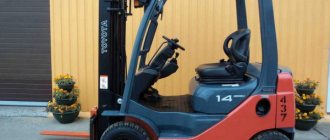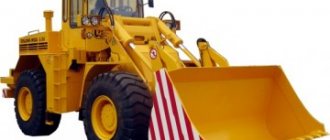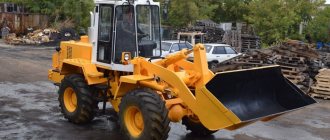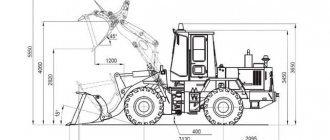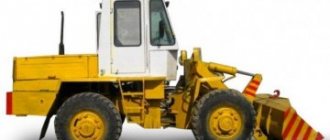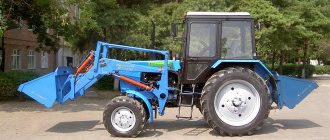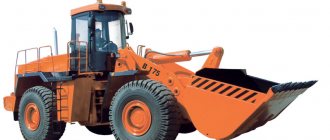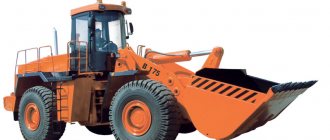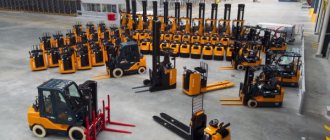A front loader is a type of special equipment for performing loading and unloading and other types of work. These machines are distinguished by their compact size, maneuverability, high power and versatility of use. Structurally, the front loader is a heavy unit with a spacious and wide bucket. While moving, it picks up bulk materials and small loads, and then moves them from one place to another, without using pushing (as is the case with bulldozers or graders).
What is a front loader: definition
The concept of a front loader and its perception are two different things. The name comes from the English language. It is derived from front - before and loader - loader. Strictly speaking, any type of loader with a working body located in front is a front-end loader, including telescopic, fork, and mini loaders.
However, the concept of a front loader is associated with four-wheeled equipment with a wide, full-width bucket. It may also be called a front loader or wheel loader. Although some machines have a tracked chassis, and some are mounted on the base of a wheeled tractor, the vast majority are made on their own chassis.
Due to its design and large selection of attachments, the front loader is widely used in various fields of activity from agriculture to the mining industry.
The history of front loaders
Front-end loaders are relatively new compared to cranes, excavators, bulldozers, scrapers, and graders. But, despite their youth, today they occupy second place in terms of market size for road construction machines after excavators.
The first front loaders were invented by farmers to make it easier to collect hay and manure. The old loader was a tractor with a bucket that was raised and lowered by winches.
A revolution in the production of these machines took place in the mid-twentieth century with the advent of hydraulics. It caused huge changes in the road construction industry. The hydraulic cylinder simplified the reciprocating movements of the working bodies and made it possible to turn using an articulated frame. This has already become a familiar all-wheel drive loader with a massive bucket, maneuverable and efficient.
Cat® Loaders
A large number of world-famous companies are engaged in the production of front loaders. A textbook example of reliable and high-performance machines in this segment is Caterpillar equipment. Its Cat® loaders are compact in size and therefore highly maneuverable - they can be used both on the construction site and in a large facility such as a warehouse.
To learn more about Cat® brand loaders, please visit our catalog product pages or the brand brochures available for download on this site. You can ask questions about purchasing new cars or renting special equipment using the contact phone number indicated at the top of the page.
Cat® 930K
The Cat® 930K Wheel Loader is equipped with a Tier3/Stage IIIA compliant Cat® C7.1 ACERT engine. Fuel economy is among the best in its class and is achieved by reducing crankshaft speed. Hybrid technology uses engine power to deliver power exactly when it's needed, for example when traveling on slopes. A high-performance mode has been developed for working in difficult conditions. The hydraulic system automatically adjusts flow and pressure according to the current load.
Z-bar linkage and parallel lift function ensure precise and safe handling of loads. Having separate pumps for each system allows simultaneous lifting, slewing and travel without compromising the quality of each operation. All maintenance points are easily accessible from ground level.
Cat® 938K
The Cat® 938K features a Z-bar excavation linkage for high efficiency. The optional parallel lift and fast loading feature allows you to quickly and accurately move the bucket to the desired location.
The continuously variable transmission is electronically controlled and regulates the transmission of force to the ground. The powerful hydraulic system monitors the current load and automatically adapts flow and pressure levels to it. The presence of a flow divider and separate pumps for each system makes it possible to simultaneously perform several operations: stroke, lifting and turning, without losing their quality. For complex tasks and intensive workloads, there is an enhanced performance mode.
Good visibility is provided by high glass and a narrow frame, which leaves the entire working area open.
Cat® 950L
The Cat® 950L is 10% less fuel efficient than comparable H-Series loaders and features the company's 252-hp C7.1 ACERT™ engine. With. Featuring a rugged power shift transmission, the Cat® 950L delivers performance and reliability even in the most challenging conditions.
The rigidly mounted front axle withstands internal torsional loads and provides strong support. The rear swings within a range of ±13°, so all wheels are in constant contact with the surface, even when driving on uneven terrain.
The cab glass provides a good overview of the work area. The Cat® 950L Loader is easy to service with all maintenance components accessible from the ground level.
Cat® 988H
The Cat® 988H Wheel Loader is used when large volumes of material need to be moved in a short amount of time. The powerful C18 ACERT™ engine and spacious bucket ensure high productivity in all jobs.
The Cat® 988H hydraulic system uses positive flow control (PFC). This allows for faster response times and a 5% reduction in fuel consumption compared to earlier models in the H range. Savings are also achieved by adapting engine speed to the current load.
The built-in AIK system automatically switches to idle speed if the loader's operating functions are not used for a certain period of time.
Additional benefits of the Cat® 988H include customizable traction. The operator can set the value from 60 to 90% of the maximum (in 10% increments).
Cat® 963D
The Cat® 963D track model is rugged and designed for off-road use. It is equipped with a C6.6 ACERT® diesel engine, which meets US (EPA Tier 3) and European (EU Stage IIIA) environmental standards in terms of emissions. Thanks to the improved ADEM™ A4 ECU, complete combustion and fuel economy and clean exhaust gases are ensured.
The frame and boom support are equipped with reinforced cross members and forged/cast elements in areas of maximum stress. The cab has a tilting design, providing easy access to the power transmission and serviced hydraulic system components.
Information about current loader parameters is displayed online on the Cat® Messenger display, allowing you to monitor the status of the equipment without interrupting the work.
General structure and technical characteristics
The main difference between loaders and other construction and road vehicles is the ratio of the load capacity and volume of the bucket to the weight of the equipment itself. This is achieved due to the optimally located center of gravity and weight distribution of the machine.
Therefore, when we talk about a front loader, we mean a classic machine with:
- four large wheels of the same diameter;
- rear engine;
- high-mounted cabin with good visibility;
- articulated frame, except for some compact and skid steer loaders;
- a large bucket located in front, which is sometimes replaced or forks, hooks, etc. are hung directly on it.
Front-end loaders are built on special wheeled chassis and have a single design. The articulated frame has a folding angle of the semi-frames in the range of 35-40°. The rear engine acts as a counterweight.
The power unit of most wheel loaders is diesel. Although more and more companies are modernizing them by installing hybrid, gas and electric engines. This is especially true for compact cars.
Typically, the use of a hydromechanical transmission with a 3- or 4-speed planetary gearbox, a drive axle with a differential lock system, a planetary wheel reduction gear, a rigid suspension of the front cargo axle and a balancer suspension of the rear axle. Sometimes, instead of a hydromechanical one, a hydrostatic continuously variable transmission is used.
The lifting boom has a Z-shaped or parallelogram design. The first is more effective when working with a front loader bucket, since it has greater breakout force. The second is preferable when changing working equipment frequently.
The ergonomics of the operator's workplace is no less important. The front loader cabin provides all-round visibility and is equipped with an adjustable seat, heating, ventilation, and noise absorption systems. The automated gear shifting and control system is designed for various operating modes selected by the operator depending on operating conditions.
The volume of a front loader bucket varies depending on the class of machine. For mini loaders it can be 0.5 cubic meters, while for mining wheeled vehicles it reaches up to 17 cubic meters.
Purpose of forklifts
Front-end loaders are in demand during construction and road repair work, in production, for organizing transportation, and in warehouse activities. Machines of this type are often present on the balance sheet of public utilities and other businesses. Most often, front loaders are used to move soil, clay, sand, and crushed stone. At construction sites, bricks, metal beams, and pipe products are transported in this way. Machines are often used to clear snow on city streets and sidewalks.
Classification and application of front loaders
Load capacity, bucket volume, engine power and productivity are the main characteristics of a front loader. This means that cars are classified according to these criteria.
By load capacity
First of all, they are divided by load capacity and dimensions. Highlight:
- heavy mining loaders with a lifting capacity of over 10 tons;
- middle class - from 5 to 10 tons;
- compact – from 2 to 5 tons;
- mini loaders – with a lifting capacity of up to 2 tons.
By chassis type
There are three types of chassis on which front loaders are assembled. The most popular is the wheeled chassis with an articulated frame. This solution increases maneuverability and cross-country ability, since the wheels follow the trail.
The equipment is also produced on a rigid frame with pneumatic wheels. Car loaders are also capable of moving independently from one site to another, but have less maneuverability due to a larger turning radius.
Tires on wheeled models of any type can be pneumatic or solid. The former have good shock-absorbing properties. The latter are used where you can come into contact with sharp materials that can damage the tire.
Since solid rubber wheels are also susceptible to damage, there is a third type of front loader - tracked. They have good maneuverability on unstable soils, and are more effective in areas with uneven, sharp surfaces - in general, where there is a high probability of a tire puncture. They have a lower center of gravity, due to which the load capacity is higher. However, the main disadvantage of this design is the limitation on speed and movement on public roads.
Other classification
Most front loaders are universal. They can use both a front bucket and various interchangeable attachments - forks, lifting hooks, wheel holders, jaw grips.
But there are also special machines. For example, low underground load-and-haul machines (LDMs) also belong to the category of front-end loaders, but due to their design features they are used only in mines.
The use of quarry loaders in other jobs is difficult due to their large overall dimensions. Also, a front-end forklift is used exclusively for warehouse work.
The largest loader on the American market
Photo source: cat.comCaterpillar 994 has been in production since 1990
Read
To be remembered. Photos of excavation equipment monuments
The Caterpillar 994K wheel loader is slightly inferior to the LeTourneau model. The supermachine weighs 240 tons, is almost 17.8 meters long and 7.1 meters high. The bucket is capable of lifting 40.8 tons of rock, while the loading height reaches 8.8 m, and with an extended boom - 9.6. In 12.6 seconds, a full cycle occurs (raising and lowering), albeit with an empty bucket.
Photo source: pinterest.com The bucket capacity is 19.1 cubic meters. m
Read
History in photographs. What was technology like in the middle of the last century?
Quite a lot of power (1,763 hp or 1,297 kW) is provided by the Cat 3516E engine. A giant with a “childish” appetite can work tirelessly for 24 hours in offline mode. For this purpose, a special tank with a volume of 5,678 liters is provided (the standard capacity is designed for 3,445 liters). The mining loader can accelerate to 24 km/h.
Photo source: cat.com Wheel diameter - 3.96 m
Where are front loaders used?
With the exception of specialty models, the primary functions of front loaders are material handling, excavation, and site grading. Loaders are also used for road repair and rigging work, garbage collection, moving crushed stone, gravel, sand and other materials.
In addition, the loader can operate in bulldozer mode, transport bulk and lump loads in a bucket, and also tow trailers or other equipment over short distances.
The largest loader on the Japanese market
Komatsu WA1200-6, weighing 220.5 tons, is considered the largest Japanese loader in the world. It can reach 19 meters in length. The operator's cabin is located at a height of almost 7 meters. Under the hood there are 1,892 “horses”, which are capable of accelerating the monster to 19.3 km/h. The fuel tank holds 5,100 liters of diesel fuel.
Photo source: komek.ru The loader is equipped with a 60 l Komatsu SDA16V160E-2 engine
Look
All advertisements for the sale of forklifts
The quarry loader is designed to handle 40-ton loads. In this case, up to 35 cubic meters of rock are placed in the bucket. All these characteristics (plus a 7-meter unloading height) make it possible to load a 200-tonne dump truck in five passes.
Photo source: komek.ru Komatsu WA1200-6 is one of the largest loaders in the world
